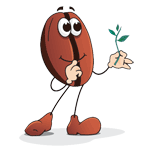|
Thought you might be interested in the economics of growing Blue Mountain coffee, and how the farmers/growers survive in the industry. To start from scratch, it is a massive investment required, and 5 to 7 years before any return is seen on the investment. Any return is very dependant on the weather ( no major hurricanes!! ) in the period while the coffee bushes, are maturing: and no drought in the first couple of years, as the coffee puts down its roots deep enough to get at the deep, ground water. Once you have got your piece of land, cleared and ready; the planting starts: along with the young coffee seedlings, in go loads of "shade" plants: the really fast growing ones ( Banana, and vegetables ) providing an income during the years of waiting for the coffee to mature. Citrus trees grow more slowly, and take about the same length of time to mature, and bear fruit, as does the coffee. Most of the small growers, around here, are always available for odd jobs, from house decorating, to coffee picking: they also supplement their income from the coffee, with these "shade" crops: as well as many other "cash crops" that they can grow in between the coffee bushes.
A Banana "flower": the fruits form in the flower, which moves downwards as the stalk elongates, when there are no more fertilised seeds in the flower, the stalk still grows, without any fruit on it. Each banana starts off pointing downwards, and as it ripens, starts to curl, and point skywards. Bananas are sold as "fingers" ( a single one ) a "hand" ( a joined bunch, of up to a dozen ) or a "head" ( the whole, intact stalk ). The Banana tree, bears just a single head of fruit, and then dies: but growing up from the root ball, are several new shoots ( locally called suckers ) at various heights; the biggest one grows quickly, and bears the next flower, it dies and the next one takes over. Up here, it takes about 10 months for the plant to produce a new head of fruit, down in Kingston, where it is a lot warmer, takes only about 8 to 9 months. A most productive plant!! Very similar to the Banana, is the Plantain; fewer fruits per head, but each one is up to 2 or 3 times the size, less sweet than a Banana, and usually eaten when shallow fried. Almost all the "tropical" fruits, grow around here: along with the coffee, on the plantation we have Guava, oranges ( 3 varieties, sweet, Artiniques, and bitter "Seville", for making marmalade ) Lemons, Limes, Tangerines, Grapefruit: and a couple of peach trees, which do not grow very well. We have a huge Mango tree, but, like the Paw Paw ( Papaya ) and the coconuts, almost never bear any fruit, as it is too cool, and damp to suit them. Pineapples grow well up here, but much more slowly than in the heat at lower elevations. Pimento trees grow wild in the bush, but it is too cool to grow them commercially. "Love Apples", a type of passion fruit, grow wild in the bush, delicious! but rarely see them on sale. Vegetables grow nicely up here: and we can have year round supplies of Tomatoes, Sweet Peppers, Cucumber, and a variety of salad Lettuce: Cauliflowers, Cabbages. The seasonal "root" vegetables we grow, include Sweet Potatoes, Yams, and Carrots. A couple of roots of Sugar Cane ( grows slowly up here ) and the inevitable wild Blackberries. Cannot confirm this, but I think there might be a few "wild" seeded Ganga bushes, in some of the more inaccessible ( well hidden from the house and the road ) places, around the plantation: as they are illegal, when ever I find one, it is destroyed!! There would be a photo of a Ganga bush here, if I had ever found one to photograph!! Have a picture of the beautiful Mountain Immortelle, instead. Other "local" crops ( which I have never seen in any English supermarkets ) Co-Co ( a root vegetable, not dissimilar to Yam ) Cho-Cho ( grows on a vine, about the size and shape of a very large pear, flavour and texture, is like a cross between a cucumber and a potato ) Callaloo ( green leaves with a flavour of a very mild spinach ), Dasheen ( similar to Cho-Cho, but a more "watery" texture ). Most Legumes ( peas and beans ) grow well, as does Corn ( Maize ): but, for undisclosed reasons, the Coffee Board strongly recommend that it is NOT grown on coffee plantations: can only surmise that they attract coffee "pests"?? Several of the local small coffee farmers keep livestock: limited to chickens, Goats, and the occasional pig. I also keep bees ( 3 hives, and expanding: but most of the locals are too afraid of the bees, to want to keep any, on their properties ) and having recently discovered the wonderful medicinal properties of the coffee fruit ( the "trash" from the pulping ) I am now processing my "coffee fruit". It contains almost 4 times as much polyphenols ( antioxidants ) as any other known plant, and appears to be beneficial, in helping to cure everything from bad breath, to colon cancer!! I have been taking a daily dose, for the last twelve months, and feel much better for it. BUT:- this is supposed to be about the coffee!! First, an explanation is needed: the "Box" of coffee: the standard local measure of cherry berries: a wooden box, internal size, 19 X 14 X 10 inches, approx 43 litres, and holds approx. 60 pounds of cherry berries. I have been unable to make any sense of the "box" in any measurement system I can find!! Closest is half a bushel ( a dry grain measure ) but still over 10% "out"! BUT: the measurements are exactly the same as the standard dimensions of a bee-hive box!! From one box of cherry berries, I should end up with between 10 and 12 pounds, of dried beans, and between 6 and 8 pounds of export quality green beans; the rest being smaller beans, and those of "poor" colour, and exported only after, roasting. A fully mature coffee bush, in a good year: will ( on average ) produce about 1/10th of a box of cherries; = about one pound of green beans, of which around 2/3rds will be of export quality. Please appreciate the difficulties of trying to give you accurate figures, as in the last 4 years, the exchange rate between the US$ and the local J$, has changed by around 35%. The exchange rate, peaked at 89.3 Jamaican $'s to one US$: 4 years ago, it was about J$65 to the US$ and now it is down to 85.6. In the 5 years I have been running this plantation, the total cost, averages out at J$100,000 per acre, per year ( US$1,600 to $1,100 ) and this cost includes everything possible, that I can even remotely justify as a business expense ( I have some accountancy training! ) even part of the cost of keeping the dogs ( under "security" ) the beekeepers expenses ( pollination ) etc. Eventually, all these expenses, will be "tax deductible", so important to account for every last cent!
Good excuse to show you a picture of my "dog pack", Mutley, ( to the left ) D'Arcy, with Becky, above them both. All local rescue dogs, and are in their favourite "guard" window, surveying their domain. With the full 4 acres in full production, we would expect between 300 and 400 boxes ; which with all the variations in the price, and the exchange rates, is worth between J$650,000, and $1.4million ( US$7,500 to $20,000 ) just selling the cherries, into the local system: might not seem a lot, but with such a low cost-of-living, in Jamaica: it is a lot of cash!! In context, it is worth about 3 or 4 times the Sterling, or US$, purchasing value, for all basic items. Up here in the mountains, an annual income of the equivalent of US$2,500, is "top", wages!! Many things are remarkable cheap: for a 4 bedroom house, on 4.25 acres, I pay J$1,000 ( about US$11.50 ) a year, in property tax!! and that is after it was raised from J$600 ( about US$7 ), in the last budget. Purchase tax, on most, but not all things ( all "basic" food is totally, tax free ) is 17.5%, and along with the ( inevitable!! ) special taxes on all fuel, I certainly do not feel "over-taxed"! My UK pension is tax free, and I pay 25% income tax, on the interest that forms my Jamaican pension fund. From the historical figures I have been able to "glean", the average price paid for a box of cherries, is US$50 ( varies slightly, in to "round figures", in J$'s ) and has remained virtually the same, for the last 10 years!!! SO:- the local small farmers/growers, have NOT had the price raised, for 12 years!! It appears that they get a better price, each year, due only to the falling value of the J$, against the US$! With virtually all the "growing requisites" ( fertilizers, herbicides, insecticides etc ) being imported, and priced against the US$, all the input costs are rising, but the price paid for the cherry-berries, remains the same! As always, it is the small grower, who gets "ripped-off"! The vast majority of the JBM grown, is grown by small farmers; as a secondary source of income; with less than an acre, or two, of coffee, and often on rough ground, with few bushes per acre. They are between a rock and a very hard place: do they spend what little money they have on fertilizers, etc, to improve their crop; only to see it all destroyed, and the money "washed/blown away", in a hurricane?? Using the figures from the local farmers association: a coffee bush should be "fed" with 2 pounds of fertilizer, per year, sprayed twice with insecticide ( specifically for the coffee borer beetle ), and a single spraying with a fungicide; at current prices, the cost of these chemicals, is about US$1.70 per coffee bush!! Add in the cost of the coffee pickers ( they will go over a plantation 3 times each season, current cost is J$800 per box picked ). On average we could expect between 50 and 80 boxes per acre, per year: these input costs, account for just over half the price paid for the cherries. In a bad year, you get almost no coffee; in a "superb" year, it could be up to 100 boxes per acre; but the input costs are more or less, constant, income from the coffee, very variable!! A single bad storm, the coffee crop destroyed, and all the expensive chemicals, washed away, and no coffee!! SO; NO income for the growers. Although, some savings can be made by using "semi-organic" methods: borer beetle traps, instead of the chemical sprays, and composted organic waste ( "topped up" with a small amount of chemical fertilizer ) money is saved, but it is a lot more work!! Small growers are the "backbone" of the whole industry: the vast majority of the JBM area, is far too steep and rough, for any form of "mechanical" cultivation: all has to be done by "hand"!! The financial realities of growing coffee: 1) Get a piece of suitable land ( around this part of the Blue Mountains, land can be leased from Wallenfords, or the Forestry Commission, with only a token annual payment, until the coffee starts to bear: but the lessee can ONLY sell the coffee to Wallenfords; who then deduct the lease costs ( all backdated!! ) directly from the payments for the coffee ) 2) Prepare the land, and plant with coffee 3) Keep the land clean, and fertilize all the coffee: spray with fungicides and insecticides ( my estimated cost, per year, for the necessary chemicals US$1.70 per coffee bush: which comes out to about US$1,000 per year, per acre of coffee, for the 7 years it takes to get the first real crop, and some income ). 4) Carry on with the above, for 6 years: and receive not a single dollar in income, but pay out an "investment", which amounts to several million J$'s: without a second source of income, you starve!! You have the full use of the leased land, and most people will use it to grow other "cash crops", to eat themselves, and make a few dollars by selling the rest. Problem is the transport costs from the JBM coffee growing areas, to the markets in Kingston: if you allow for the cost of the vehicle/fuel, it is difficult to compete with the farmers with farms much closer to Kingston. 5) Years 6/7, and you crop your coffee, and take it down to Wallenfords factory: you get paid for the coffee, minus a large proportion of the accumulated lease costs. They may have supplied you with some free fertilizer, and that cost is also deducted ( they price is not based on the cost of 7 years ago, when they gave it to you, but on the current ( plus inflation ) replacement cost, along with interest payments on the monies at Jamaican interest rates!! All the above assumes that your plantation is not badly damaged, or destroyed, by a hurricane, as it is growing. No serious drought occurs, during the first 2/3 years, the time taken for the coffee to put down deep roots, to get at the water several feet below the surface. AND, that when your crop is ready to pick, you can pick it before one of the roaming gangs of coffee thieves, attacks it. ( coffee growing is the biggest industry around here, and coffee thieving, the second!! ), but we have to observe, that with the lower price, even the coffee thieves have not been very busy!! At current prices, it cost J$800 for a coffee picker to pick a box of coffee: then you have the vehicle costs to get the coffee to the factory, and you receive just J$1,500, the pickers expect a cash payment at the end of 2 weeks: and with the current several weeks delay in you getting your money from the factory; you cannot pay them: many farmers are not picking the coffee, and just letting it rot on the bushes!! I have heard that there is a similar situation in Puerto Rico, the current value of the coffee, does not cover the cost of employing the pickers, to pick it.These problems are not confined to Jamaica, but spread throughout the worlds' coffee growers. To be continued here ... Best wishes to all, my readers. Robin Plough, friend of www.coffee4dummies.com
|
Coffee Economics of JBM. Part 1
Coffee Economics of JBM. Part 1









